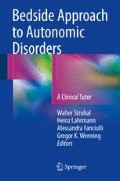Abstract
Disorders of the autonomic nervous system (ANS) are often a severe burden to the quality of life of our patients (e.g., orthostatic intolerance, sweating disorders, sexual dysfunction). In some cases, they may be harmful (syncope with falls, heat intolerance, urinary retention) or even life threatening (sudden cardiac death, sympathetic storm, heat shock). Diagnosis of ANS disorders is still underrepresented, despite their common occurrence in clinical practice. This may be attributed at least in part to a lack of awareness and attention to symptoms of ANS dysfunction. Information on the ANS is rare in many neurological textbooks and often missing during education. This booklet shall help to recognize the presence and distribution of autonomic dysfunctions and provide tips for further management. The clinical investigations of autonomic functions presented here refer to the office, bedside, or prelaboratory evaluation. It cannot and shall not replace any textbook in this growing, neurological field.
H. Lahrmann, W. Struhal together with all co-authors.
Access this chapter
Tax calculation will be finalised at checkout
Purchases are for personal use only
References
Lahrmann H, Magnifico F, Haensch CA, Cortelli P (2005) Autonomic nervous system laboratories: a European survey. Eur J Neurol 12:375–379
Winker R, Prager W, Haider A, Salameh B, Rudiger HW (2005) Schellong test in orthostatic dysregulation: a comparison with tilt-table testing. Wien Klin Wochenschr 117:36–41
Ewing DJ, Clarke BF (1982) Diagnosis and management of diabetic autonomic neuropathy. Br Med J 285:916–918
Low PA, Sandroni P, Benarroch EE (2008) Clinical autonomic disorders: classification and clinical evaluation. In: Low PA, Benarroch EE (eds) Clinical autonomic disorders, 3rd edn. Wolters Kluwer, Philadelphia, pp 1–17
Benarroch EE (1993) The central autonomic network: functional organization dysfunction, and perspective. Mayo Clin Proc 68(10):988–1001
Struhal W, Hoedl S, Lahrmann H, Toeglhofer E, Gruber F, Vosko M, Ransmayr G (2011) Reliability of the noninvasive sequence methods to estimate baroreflex function using the paradigm of brain death. Auton Neurosci 161(1–2):43–45
Lahrmann H et al (2006) EFNS guidelines on the diagnosis and management of orthostatic hypotension. Eur J Neurol 13:930–936
Ward SM, Sanders KM (2006) Involvement of intramuscular interstitial cells of Cajal in neuroeffector transmission in the gastrointestinal tract. J Physiol 576(Pt 3):675–682
Olsson C, Holmgren S (2001) The control of gut motility. Comp Biochem Physiol 128:481–503
Altaf MA, Sood MR (2008) The nervous system and gastrointestinal function. Developmental disabilities research reviews 14:87–95
Drake MJ, Fowler CJ, Griffiths D, Mayer E, Paton JF, Birder L. Neural control of the lower urinary and gastrointestinal tracts: supraspinal CNS mechanisms. Neurourol Urodyn. 2010;29(1):119–27.
Grimaldi D, Silvani A, Benarroch EE, Cortelli P (2014) Orexin/hypocretin system and autonomic control: new insights and clinical correlations. Neurology 82:271–278
American Academy of Sleep Medicine (AASM) (2014) The international classification of sleep disorders, 3rd edn. American Academy of Sleep Medicine, Darien, IL, 2014.
Boudreau P, Yeh WH, Dumont GA, Boivin DB (2013) Circadian variation of heart rate variability across sleep stages. Sleep 36(12):1919–1928. doi:10.5665/sleep.3230
Task Force of the American Academy of Sleep Medicine (2009) Clinical guideline for the evaluation, management and long-term care of obstructive sleep apnea in adults. J Clin Sleep Med 5(3):263–276
Tobaldini E, Nobili L, Strada S, Casali KR, Braghiroli A, Montano N (2013) Heart rate variability in normal and pathological sleep. Front Physiol 4:294. doi:10.3389/fphys.2013.00294
Author information
Authors and Affiliations
Corresponding author
Editor information
Editors and Affiliations
Rights and permissions
Copyright information
© 2017 Springer International Publishing Switzerland
About this chapter
Cite this chapter
Lahrmann, H., Struhal, W. (2017). General Approach to Patients with Autonomic Disorders: “What Is the Autonomic Disease?” – A Basic Tutorial to Autonomic Physiology and Pathophysiology. In: Struhal, W., Lahrmann, H., Fanciulli, A., Wenning, G. (eds) Bedside Approach to Autonomic Disorders. Springer, Cham. https://doi.org/10.1007/978-3-319-05143-7_1
Download citation
DOI: https://doi.org/10.1007/978-3-319-05143-7_1
Published:
Publisher Name: Springer, Cham
Print ISBN: 978-3-319-05142-0
Online ISBN: 978-3-319-05143-7
eBook Packages: MedicineMedicine (R0)

